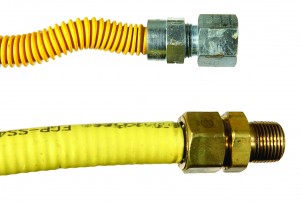Yellow Gas Piping in Your Home May Pose a Safety Risk
Insurance Commissioner | Date Posted: Thursday, June 18, 2015
Insurance Commissioner | Date Posted: Thursday, June 18, 2015

DOVER, DE – The Delaware Department of Insurance, the National Association of Insurance Commissioners (NAIC) and the National Association of State Fire Marshals (NASFM) are teaming up to educate homeowners on a potential safety risk involving yellow flexible gas piping. The gas piping is known as corrugated stainless steel tubing, or “yellow CSST.”
“Homes with yellow CSST are at risk of perforation to the gas line caused by lightning strikes which could cause gas leaks or fires,” says Insurance Commissioner Karen Weldin Stewart. “If you are unsure as to whether your home has CSST or whether it has been properly bonded and grounded, contact a licensed electrician to arrange for a professional inspection.”
CSST is a flexible, stainless steel pipe used to supply natural gas and propane in residential, commercial and industrial structures. Coated with a yellow or occasionally black exterior plastic coating, CSST is usually routed beneath, through and alongside basement floor joists, inside interior wall cavities, and on top of ceiling joists in attic spaces. Although national gas codes and some building codes now require new construction and remodeling projects to reduce the lightning risk associated with yellow CSST, many homes built or remodeled after 1990, but before the codes changed, are still at risk.
If you find CSST after inspecting your home or business, it is strongly recommended that you determine if the CSST system is properly bonded and grounded. A bonding device should be installed on your natural gas system in order to reduce the chances of a natural gas leak or fire. Bonding is provided primarily to prevent a possible electric shock to people who come in contact with the gas piping and other metal objects connected to the grounding system. Nearby lightning strikes can also result in an electrical surge and can potentially puncture a hole in the CSST.
Please see the pictures of CSST below. Not all CSST piping looks exactly the same. More information and pictures can be found at www.csstsafety.com.


Examples of various CSST piping, which is most often covered with a yellow plastic or rubber casing. Some CSST comes with black casing.
###
The Delaware Department of Insurance mission: Protecting Delawareans through
regulation and education while providing oversight of the insurance industry to best serve the public.
Delaware Department of Insurance | www.delawareinsurance.gov | 302.674.7300
More news from the Department of Insurance: http://www.delawareinsurance.gov/newsroom.shtml
Questions? Contact Jerry Grant at (302) 674-7303
Related Topics: fire safety, insurance, Insurance Commissioner, Karen Weldin Stewart, National Association of Insurance Commissioners
Keep up to date by receiving a daily digest email, around noon, of current news release posts from state agencies on news.delaware.gov.
Here you can subscribe to future news updates.
Insurance Commissioner | Date Posted: Thursday, June 18, 2015

DOVER, DE – The Delaware Department of Insurance, the National Association of Insurance Commissioners (NAIC) and the National Association of State Fire Marshals (NASFM) are teaming up to educate homeowners on a potential safety risk involving yellow flexible gas piping. The gas piping is known as corrugated stainless steel tubing, or “yellow CSST.”
“Homes with yellow CSST are at risk of perforation to the gas line caused by lightning strikes which could cause gas leaks or fires,” says Insurance Commissioner Karen Weldin Stewart. “If you are unsure as to whether your home has CSST or whether it has been properly bonded and grounded, contact a licensed electrician to arrange for a professional inspection.”
CSST is a flexible, stainless steel pipe used to supply natural gas and propane in residential, commercial and industrial structures. Coated with a yellow or occasionally black exterior plastic coating, CSST is usually routed beneath, through and alongside basement floor joists, inside interior wall cavities, and on top of ceiling joists in attic spaces. Although national gas codes and some building codes now require new construction and remodeling projects to reduce the lightning risk associated with yellow CSST, many homes built or remodeled after 1990, but before the codes changed, are still at risk.
If you find CSST after inspecting your home or business, it is strongly recommended that you determine if the CSST system is properly bonded and grounded. A bonding device should be installed on your natural gas system in order to reduce the chances of a natural gas leak or fire. Bonding is provided primarily to prevent a possible electric shock to people who come in contact with the gas piping and other metal objects connected to the grounding system. Nearby lightning strikes can also result in an electrical surge and can potentially puncture a hole in the CSST.
Please see the pictures of CSST below. Not all CSST piping looks exactly the same. More information and pictures can be found at www.csstsafety.com.


Examples of various CSST piping, which is most often covered with a yellow plastic or rubber casing. Some CSST comes with black casing.
###
The Delaware Department of Insurance mission: Protecting Delawareans through
regulation and education while providing oversight of the insurance industry to best serve the public.
Delaware Department of Insurance | www.delawareinsurance.gov | 302.674.7300
More news from the Department of Insurance: http://www.delawareinsurance.gov/newsroom.shtml
Questions? Contact Jerry Grant at (302) 674-7303
Related Topics: fire safety, insurance, Insurance Commissioner, Karen Weldin Stewart, National Association of Insurance Commissioners
Keep up to date by receiving a daily digest email, around noon, of current news release posts from state agencies on news.delaware.gov.
Here you can subscribe to future news updates.